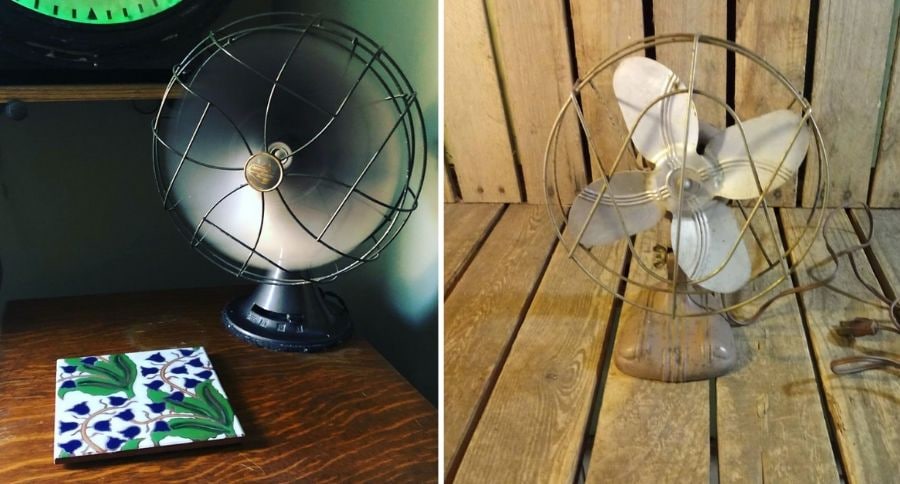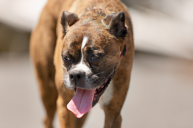Do fans work on dogs? When summer temperatures reach up into the '70s, '80s, '90s, and even past 100 degrees, chilling out in front of the AC is often feels like the best way to spend the day with your dog. But if AC isn't available or - gasp! - breaks, a fan might be the next best option. But do fans actually work to cool off your pup?
Your first instinct might be to say, of course! After all, sitting in front of a fan feels so much better than simply sitting in a hot room or vehicle. But when you consider the fact that fans move air across your skin, and you're probably already sweating, you start to understand that fans aren't actually cooling the air, but are instead cooling your sweat. Then, the question of whether fans are effective for dogs in the summer becomes a lot more complicated.
How fans work
Fans don't actually cool down a room at all, according to How Stuff Works. So they don't actually cool dogs down. Instead, fans create a wind-chill effect with moving air that makes it easier for the sweat on your skin to evaporate. As your sweat evaporates, it helps to draw out some of your body heat, leaving you feeling cooler.
If you turn up the fan, it blows larger amounts of air toward you, speeding up the sweat evaporation so you feel even cooler. The air might feel cool against your skin, but that coolness that you're feeling actually results from your sweat evaporating.
You would think that your dog might experience this same effect from a crate fan or even by lying in front of a box fan, but there's one problem with that idea: Dogs don't really sweat.
How dogs cool down
According to Pet MD, dogs cool down in very different ways than humans do. Dogs sweat a little bit through the pads of their feet, but they mostly cool down by panting. As a dog pants, he moves air through his body, which helps to draw heat out and cool him down.
Dogs can also cool down by jumping into some cool water, which also draws heat out and away from their bodies and reduces their body temperature. Because they have such thick coats, though, dogs don't sweat through their bodies like we do.
Fans and dogs: effective?
According to Dr. Jerry Klein, chief veterinary officer of the American Kennel Club, fans aren't super effective in helping dogs to cool down. A kennel fan or other type of cooling fan might help to make a dog feel a bit better when temperatures are lower, such as in the 70's or 80's. But when the temperatures climb higher, fans won't do much to keep your dog cool.
When the temperature is high, a fan blows hot air around. Because your dog doesn't sweat through most of his body, you're just blanketing him in that hot air, rather than cooling him off. If your dog stays in these high temperatures on hot days for too long, he could be at risk of heatstroke.
Recognizing heatstroke
Heatstroke in dogs refers to hyperthermia, according to VCA Hospitals. If your dog's body temperature gets to 103 degrees Fahrenheit or higher, that's considered an abnormal temperature. When a dog's body temperature climbs to 106 degrees Fahrenheit, he's said to be experiencing heatstroke.
Leaving a dog in a car without adequate air circulation can result in overheating and cause heatstroke. Exercising a dog during very hot summer temperatures or leaving him outside in the summer without access to shade and cool water can also cause heatstroke.
Treating heatstroke
Heatstroke is an emergency, and it's important to recognize that your dog is in trouble and get him the treatment that he needs. Pet MD states that heat stroke symptoms in dogs include excessive drooling, heavy panting, a high body temperature, red gums, dehydration, a rapid heart rate, and shock. A dog experiencing heatstroke may not produce normal amounts of urine and may vomit, experience muscle tremors, and have seizures. Left untreated, heatstroke can cause death in dogs.
If your dog is experiencing heatstroke, you'll need to cool him down immediately. Set up a cooling system by spraying him with cool water or wrap him in cool, wet towels or a cooling mat or blanket. You can also put isopropyl alcohol on your dog's footpads and under his forelegs to help with evaporative cooling. You can allow your dog to drink some cool - but not cold - water.
Never put cold water or ice water on your dog, since this can result in other health problems. It's tempting to quickly lower your dog's temperature, but it's best to do this process gradually. Immediately get your dog to the vet for medical treatment, even if you've been able to return his body temperature to normal.
Alternatives to fans
So here's the bottom line: do fans work on dogs? Not technically. Fans aren't terribly effective for dogs, but there are plenty of other options to cool a dog down. Your dog would benefit from some traditional air conditioning in your home or in your car to generate cool air. Keeping your dog in a shaded place and drawing the blinds across windows during the day can help to keep him cool.
If your dog loves swimming, he'll probably enjoy a swim in some cool weather during the summer. Not near a lake or the ocean? Set up a kiddie pool in your backyard or hook up a sprinkler and let your dog play. Staying cool can be fun and entertaining for both of you, no fans required.
READ MORE: 15 BIG RETAIL CHAINS YOU DIDN'T KNOW WERE PET FRIENDLY




